Absorption By Roots
Exercise 1
Solution A.1.
c) Imbibition
Solution A.2.
c) Hypertonic salt solution
Solution A.3.
b) Turgidity
Solution A.4.
d) Grow downward into the soil
Solution A.5.
b) Diffusion
Solution A.6.
c) a selectively permeable membrane in between
Solution A.7.
a) Pure water
Solution A.8.
d) water
Solution A.9.
b) Root pressure
Solution A.10.
d) it allows a solvent to pass through freely but prevents the passage of the solute
Solution B.1.
(a) Turgidity
(b) Guttation
(c) Osmosis
(d) Xylem
(e) Endosmosis
(f) Diffusion
(g) Root pressure
Solution B.2.
(a) Turgor pressure
(b) Flaccidity
(c) Bleeding
Solution B.3.
(a) the fluids inside
(b) transported inside against their concentration gradient
(c) turgor movements
Solution B.4.
(a) shrink
(b) water
(c) opposite
Solution B.5.
| Column I | Column II | |
| a | Xylem | (iv) upward flow of water |
| b | Phloem | (iii) downward flow of sap |
| c | Cell membrane | (i) semi-permeable |
| d | Root pressure | (v) guttation |
| e | Cell wall | (ii) permeable |
Solution C.1.
(a)
| Plasmolysis | Deplasmolysis |
| 1. It refers to the
shrinkage of the cytoplasm and withdrawal of the plasma membrane from
the cell wall caused due to the withdrawal of water when placed in a
hypertonic solution.
2. In Plasmolysis, the cell becomes flaccid. |
1.Deplasmolysis is the recovery of a plasmolysed cell when it is placed in water, wherein the cell’s protoplasm again swells up due to the re-entry of water. 2. In deplasmolysis, the cell becomes turgid. |
(b)
| Turgor pressure | Wall pressure |
| Turgor pressure is the pressure of the cell contents on the cell wall. | Wall pressure is the pressure exerted by the cell wall on the cell content. |
(c)
| Guttation | Bleeding |
| Guttation is the process by which drops of water appear along leaf margins due to excessive root pressure. | Bleeding is the loss of cell sap through a cut stem. |
(d)
| Turgidity | Flaccidity |
| 1. It is the state of a cell in which the cell cannot accommodate any more water and it is fully distended. | 1. It is the condition in which the cell content is shrunken and the cell is not tight. |
Solution C.2.
(a)
- False
- False
- False
- True
- False
- False
(b)
- A plant cell placed in hypotonic solution gets turgid.
- Addition of salt to pickles prevents growth of bacteria because they turn flaccid.
- Cells that have lost their water content are said to be plasmolysed.
- The shrinkage of protoplasm, when a cell is kept in hypertonic solution.
Solution C.3.
The cell is said to be turgid when the plant cell wall becomes rigid and
stretched by an increase in the volume of vacuoles due to the
absorption of water when placed in hypotonic solution. On the other
hand, the cell is said to be flaccid when the cell contents get shrunken
when the cell is placed in hypertonic solution and the cell is no more
tight. Flaccidity is the reverse of turgidity.
Example: Weeds can be killed in a playground by sprinkling excessive salts around their base.
Or
A plant cell when immersed in hypertonic solution like salt solution for about 30 minutes will become flaccid or limp.
Solution C.4.
(a) Common salt when sprinkled on the grass causes the Plasmolysis of grass cell ultimately leading them to death. Hence, if we sprinkle some common salt on grass growing on a lawn, it is killed at the spot.
(b) If a plant is uprooted, the leaves continue losing water by transpiration, but there is no more water absorbed the roots. This does not allow the compensation for the loss of water by transpiration; hence the leaves of the uprooted plant wilt soon.
(c) Transplantation causes stress to the seedlings. If the seedlings are transplanted in the morning, they would have to immediately bear the additional stress of excessive transpiration occurring during the hot afternoon. Transplantation in the evening helps the seedlings to adjust for a longer time during the night (cooler temperatures) because the quantity of water absorbed exceeds the loss of water through transpiration. Therefore, it is better to transplant seedling in a flower bed in the evening and not in the morning.
(d) In a hypertonic solution, the solution outside the cell has higher solute concentration than the fluids inside the cell. Therefore, water flows out from the plant cell due to exosmosis. The cytoplasm shrinks and the plasma membrane withdraws away from the cell wall and this the cell becomes flaccid. Hence a plant cell when kept in a hypertonic salt solution for about 30 minutes turns flaccid.
(e) Potato cubes contain excess of salts and sugars as compared to the water in which the cubes are placed. Hence, due to endosmosis, water from the surrounding enters the potato cubes making them firm and increasing their size.
Solution C.5.
(a) True.
Plasmolysis occurs due to outflow of water from the cell when placed in
hypertonic solution due to which the cytoplasm shrinks away from the
cell wall. On the other hand, deplasmolysis is the result of the
re-entry of water into the plasmolysed cell when placed in hypotonic
solution due to which the protoplasm again swells up pressing tight
against the cell wall.
(b) False.
Guttation is the process by which drops of water appear along leaf
margins due to excessive root pressure whereas bleeding is the loss of
cell sap through a cut stem.
(c) False.
There is only one seed coat in a seed.
(d) False.
The leaves of the twig remain turgid since its xylem is intact and xylem is responsible for water conduction in plants.
(e) False.
Guttation occurs due to excessive root pressure. It is maximum when root
pressure is maximum which occurs in the early mornings or at night.
This is because during these times, transpiration is very low and water
absorption is very high.
(f) False.
Dry seeds when submerged in water swell up due to imbibitions. On contact with water dry seeds imbibe water and swell up.
Solution D.1.
Examples of turgor movements in plants:
- In Mimosa pudica, a sensitive plant, the stimulus of touch leads to loss of turgor at the base of the leaflets and at the base of the petioles called pulvinus. This causes the folding and drooping of leaves of the plant.
- The leaves of insectivorous plants close up to entrap a living prey. When the insect come in contact with the leaf, it loses it turgor hence closing the leaves of the plant.
- The bending movements of certain flowers towards the sun.
(Any two)
Solution D.2.
The closing and opening of the stomata depends on the turgidity of the
guard cells. Each guard cell has a thicker wall on the side facing the
stoma and a thin wall on the opposite side. Guard cells contain
chloroplasts. As a result of the synthesis of glucose during
photosynthesis and some other chemical changes, the osmotic pressure of
the contents of the guard cells increases and they absorb more water
from the neighbouring cells, thus becoming turgid. Due to turgor, the
guard cells become more arched outwards and the aperture between them
widens, thereby opening the stoma.
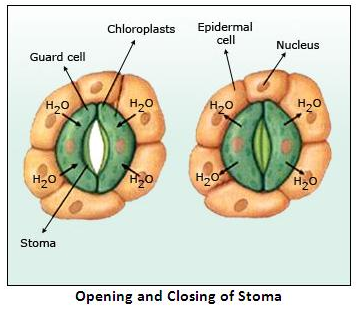
At night or when there is shortage of water in the leaf, the guard cells
turn flaccid and their inner rigid walls become straight, thus closing
the stomatal aperture.
Solution D.3.
If the concentration of mineral nutrient elements is higher inside the
root-hairs than in the surrounding soil, then roots take them in from
the soil by ‘active transport’. In active transport, the mineral ions
are forcibly carried from the surrounding soil i.e. the region of their
lower concentration into the roots i.e. the region of their higher
concentration through the cell membrane by expenditure of energy. This
energy is supplied by the cell in the form of ATP.
Solution D.4.
When soaked in water, the seeds swell up due to imbibition and
endosmosis. During these two processes water enters the cell. Due to
endosmosis, at some point, the seed coat is unable to bear the turgor
pressure and hence, the seed coat bursts.
Solution D.5.
Leaves of the sensitive plant wilt and droop down on a slight touch due
to turgor movement. Petiole of sensitive plant is held up by turgid
pulvinus tissue. The stimulus of touch leads to loss of turgor at the
base of the leaflets and at the base of the petioles i.e. pulvinus. The
cells of the lower side of pulvinus lose water and the petiole
collapses. This causes the wilting and drooping of the leaves.
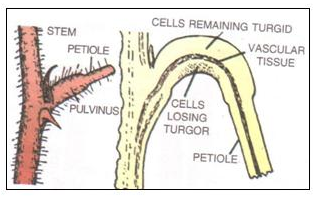
Solution D.6.
As water is lost from the leaf surface by transpiration, more water
molecules are pulled up due to the tendency of water molecules to remain
joined i.e. cohesion. This produces a continuous column of water
throughout the stem which is known as ‘transpiration pull’. A negative
pressure or tension is produced in the xylem that pulls the water from
the roots and soil. Transpirational pull is an important force which
causes the ascent of sap.
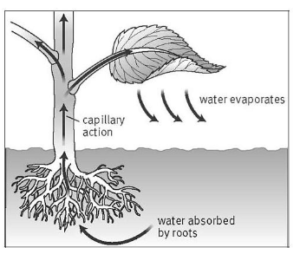
Solution E.1.
(a) The cell is flaccid i.e. it is plasmolysed.
(b) Plasma Membrane
(c) Plasmolysis would not occur and flaccidity would not be seen i.e.
the protoplasm would not have shrunken away from the cell wall.
(d) Cell Wall is absent in animal cell.
Solution E.2.
(a) Flaccid Cell
(b) The liquid is hypertonic solution. It has higher solute concentration outside the cell than the fluids inside the cell.
(c)
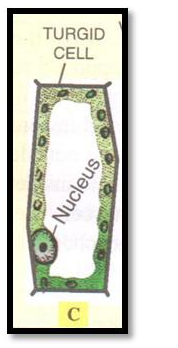
Solution E.3.
(a) Osmosis
(b) Osmosis is the diffusion of water molecules across a semi-permeable membrane from a more dilute solution (with a lower solute concentration) to a less dilute solution (with a higher solute concentration).
(c) After an hour or so, the level of sugar solution in the thistle funnel will rise and the level of water in the beaker will drop slightly.
(d) For control experiment, the beaker will contain the water. At the same time, instead of the sugar solution; the thistle funnel with the cellophane paper tied on its mouth and inverted in the beaker will also contain water.
(e)
- concentrated sugar solution – Cell sap (of higher concentration than that of the surrounding water) within the root hair.
- parchment paper – cell membrane of root hair.
- water in the beaker – water in soil.
(f) cellophane paper, egg membrane, animal bladder (any one)
(g)
- The roots of plants absorb water and minerals from surrounding soil due to osmosis.
- Osmosis allows plants to absorb water from the soil which helps plants to keep cells alive in roots, stems and leaves.
- Osmosis is also important in the opening and closing of stomata which is an important feature for the processes like transpiration and photosynthesis. (Any two)
Solution E.4.
a.
A – Cell wall
B – Cell membrane
C – Cytoplasm
D – Nucleus
b. A root hair gets turgid because of the absorption of water from the surrounding. Absorption of water by root hair is achieved by the process of osmosis. The concentration of water in the surrounding is more than that of the interior of the cell; this causes the water from the surrounding to move in because of endosmosis.
c.
| Cell wall | Cell membrane |
| The cell wall of a root hair is freely permeable and allows both salt and water to pass through. | The cell membrane of a root hair is semi-permeable and does not allow large dissolved salt molecules to pass through. |
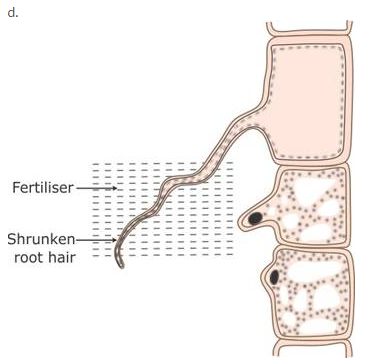
Solution E.5.
(a) Water is hypotonic to the potato cells, due to which endosmosis occurs and water enters the potato cells. The protoplasm swells up pressing tight against the cell wall. The cells are fully distended i.e. turgid. This causes the firmness and increase in the size of the potato cubes when placed in water.
(b) Sugar solution is hypertonic to the potato cells, due to which exosmosis occurs and water flows out of the potato cells. The potato cell loses its distended appearance, the cytoplasm shrinks and the plasma membrane withdraws from the cell wall. The cells become limp or flaccid. This causes the softness and decrease in size of the potato cubes when placed in sugar solution.
(c) The process being investigated is osmosis. Osmosis is the diffusion of water molecules across a semi-permeable membrane from a more dilute solution (with a lower solute concentration) to a less dilute solution (with a higher solute concentration).
Solution E.6.
(a) It is the diagrammatic cross-section of a part of a root.
(b)
- Root hair
- Epidermis
- Cortex
- Endodermis
- Phloem
- Xylem
(c) Cortex (label 3) is the ground tissue and is active in the uptake
of water and minerals. It also helps in storage of photosynthetic
products.
Phloem (label 5) helps in transporting the prepared food from leaves to different parts of the plant.
Solution E.7.
(a) The process of water absorption by plant roots through osmosis is being studied here.
(b) A root-hair contains cell sap which contains higher concentration of salts as compared to outside soil water. This difference sets off osmosis and outside water diffuses into the root-hair. From the cell bearing root-hair, water passes into adjoining cells one after another to finally the xylem vessels.
(c) The surface of water was covered with oil to prevent any loss of water by evaporation.
Solution E.8.

Comments
Post a Comment